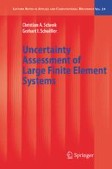Search
Search Results
-
Out-of-Plane Vibrations of Plane Frames
The frame vibrations studied in Chaps. 3 to 5 are for in-plane vibrations. If a plane frame acted upon by a force or horizontal ground vibration in...
-
Vibrations of Frames with Inclined Members
The model established for the vibration of the inclined bars in the last chapter now is applied to two- and three-bar frames with inclined members.
-

-
Aerothermodynamics, Nonlinear Acoustics and the Meteorological Equations
The study of low-Mach-number flows occurs in the general context of asymptotic modelling of fluid flows, and in a recent book (Zeytounian 2004, Chap....
-
Vibrations of X-Braced Multi-Story Frames
The study of vibrations for the x-braced portal frames in the last chapter is extended to high-rise x-braced multi-story frames in this chapter....
-
Dumbbell Model for Dilute and Semi-Dilute Solutions
Dumbbell models are very crude representations of polymer molecules. Too crude to be of much interest to a polymer chemist, since it in no way...
-
Conical Shells of Linearly Varying Thickness Subjected to Normal Loads
The equilibrium equations for a surface element of a conical shell in the framework of generalized plane stress of linear theory of elasticity are...
-
Equilibrium Statistics: Monte Carlo Methods
Monte Carlo methods use random numbers, or ‘random’ sequences, to sample from a known shape of a distribution, or to extract distribution by other...
-
Some Aspects of Low-Mach-Number External Flows
In this chapter, we consider first, in Sect. 4.1, a detailed derivation of the Navier–Fourier initial–boundary–value problem for the Navier velocity...
-
Comparison of Single and Two‐Fluid Approaches
The results of the “0D„ analyses gathered in Tables 5.1 and 6.1 and discussed in Sects. 5.3 and 6.2 provide the basis for comparing Dam's к–ε and...
-
Conclusion, Future Modeling Trends
The relevance of this study stands not in the topics that have been discussed, since most of them have already been explored for many years now, but...
-
Single‐Fluid Approach: Example of Dam's к–ε Model
The statistical equations for the turbulent flow of an incompressible fluid are found in the literature [58], but they are adapted here to the...
-
Specific Treatment of Shocks: Constraints on Models1
Before examining the phenomenology of the interaction between a shock and turbulent or material heterogeneities, it is useful to recall that the...
-
Two‐Fluid Approach: Example of Awe's Model
Two‐fluid descriptions often use explicitly separate treatments for the conservation equations in each fluid, along with expressions for exchange...
-
A Imperfection Data Bank
For the stochastic modeling of geometric imperfections as described in Sec. 12.1, a database [5] has been available. This database provides...
-
7 Rational Treatment of Uncertainties
Structural analysis up to this date, generally is still based on a deterministic conception. Observed variations in loading conditions, material...
-
4 Finite Element Method
In this chapter, the fundamentals of the displacement-based finite element method are reiterated in a concise form, details can be found in a number...
-
9 Direct Monte Carlo Simulation
The evaluation of the stochastic response by the Monte Carlo simulation technique is a powerful method for highly nonlinear systems as well as for...
-
11 Random Vibrations of Large Finite Element Systems
The basic idea for the computation of the stochastic response is based on the Karhunen-Loève expansion of the stochastic loading. For each Karhunen-...
-
5 Non-Linear Static Analysis
The state of the art in the capability to predict the stability behavior of shell structures refers to areas such as asymptotic analysis [69] and...
